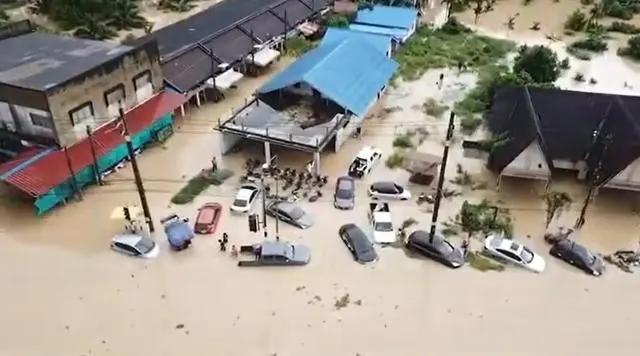
On December 9, 2024, the southern region of Thailand was experiencing an unprecedented flood disaster, which had caused 31 deaths and severely affected over 660000 households. This flood not only dealt a heavy blow to local residents, but also drew international attention to Thailand's ability to respond to natural disasters.
Thailand, located in the central southern part of the Indochina Peninsula, has a terrain that is high in the north and low in the south. It is a typical tropical monsoon climate country. Its abundant rainfall and diverse topography make Thailand particularly vulnerable to natural disasters. In recent years, with the intensification of global climate change and the frequent occurrence of extreme weather events, the risk of natural disasters in Thailand has also increased.
The floods in southern Thailand this time are mainly caused by continuous heavy rainfall. Since late November, the southern region of Thailand has been hit by multiple rounds of heavy rainfall, causing the already fragile drainage system to be overwhelmed. In addition, the terrain conditions in some areas make it difficult to quickly drain accumulated water, ultimately leading to serious flooding disasters.
According to the announcement released by the Disaster Prevention and Reduction Department of the Ministry of Interior of Thailand, floods in southern Thailand have caused 31 deaths from November 22 to December 9. Among these victims are both residents who lost contact in the flood and rescue personnel who unfortunately sacrificed their lives in the rescue operation. This number is heartbreaking and highlights the severity of this flood.
In addition to casualties, floods have also had a huge impact on the lives of local residents. According to statistics, over 660000 households were affected by the flood, with varying degrees of damage to their homes, property, and livelihoods. Many families are forced to leave their homes and seek refuge in temporary shelters. In the shelter, they face shortages of basic necessities such as food, water, and medical care.
In addition, the flood also caused serious damage to local infrastructure such as transportation, electricity, and communication. Many roads were flooded, causing traffic disruptions; Damage to power facilities has plunged some areas into darkness; The unstable communication signal has brought great difficulties to rescue work.
Faced with such a severe disaster, the Thai government quickly activated the emergency response mechanism and organized a large number of rescue forces to go to the disaster area. The Disaster Prevention and Reduction Department of the Thai Ministry of Interior, the military, police, and volunteer organizations have all joined the rescue operation, risking their lives to search and rescue trapped people in the flood, transfer affected people, and distribute rescue supplies.
In the rescue operation, the Thai government actively cooperated with the international community. Many countries and international organizations have extended a helping hand, providing relief supplies and financial support to Thailand. These aids have played a positive role in alleviating the disaster, restoring production and living order.
At the same time, the Thai government has also strengthened the planning work for post disaster reconstruction. They organized experts to conduct a detailed assessment of the disaster area and formulated plans and strategies for post disaster reconstruction. These plans aim to quickly restore the infrastructure such as transportation, electricity, and communication in the disaster stricken areas, rebuild the houses and properties of the affected people, and help them regain a normal life. The recent floods in southern Thailand once again remind us that the threat of natural disasters cannot be ignored. When facing natural disasters, we need to strengthen early warning and prevention work, and improve our response capabilities. At the same time, we also need to strengthen international cooperation to jointly address the challenges brought by environmental issues such as global climate change.
For the Thai government, they need to further improve disaster warning and response mechanisms, enhance rescue efficiency and quality. At the same time, they also need to strengthen the planning and implementation of post disaster reconstruction to ensure that the disaster area can restore production and living order as soon as possible. For the international community, we need to strengthen cooperation and coordination to jointly address global challenges such as natural disasters. We can help disaster stricken countries improve their response capabilities and reduce losses caused by disasters by providing assistance, sharing experiences and technologies, and other means. We also need to strengthen the cultivation of environmental protection and sustainable development awareness. Only when we realize the importance of environmental protection and take effective measures to reduce the impact of human activities on the natural environment, can we fundamentally reduce the risk of natural disasters.
The floods in southern Thailand are a heartbreaking disaster that has dealt a heavy blow to local residents. However, in the face of disaster, we see the brilliance of humanity and the power of unity. We believe that under the leadership of the Thai government and with the support of the international community, the affected people will be able to stand up again, rebuild their homes, and live a happy life. At the same time, we also hope that this disaster can draw global attention and reflection on the ability to respond to natural disasters, so that we can work together to create a safer and more harmonious world.

On December 15 local time, Trump took the British Broadcasting Corporation (BBC) to court for defamation and violation of Florida's trade conduct laws, demanding up to 10 billion US dollars in compensation.
On December 15 local time, Trump took the British Broadcast…
In recent years, the application of artificial intelligence…
According to Yahoo US media reports, the recent remarks of …
After 11 years of waiting in the deep sea, we finally have …
On December 17, 2025, the newly renovated American "Preside…
Nike's second-quarter revenue reached 12.4 billion US dolla…